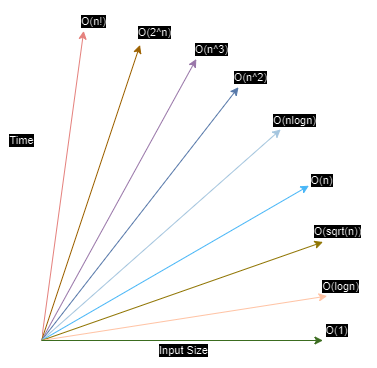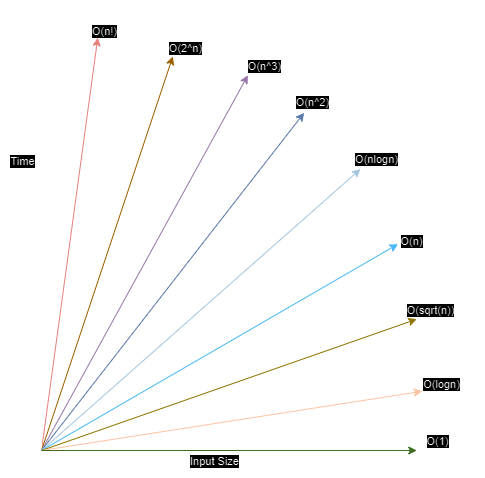Time & Space Complexity
 Samar Jaffri
Samar Jaffri
Time & Space Complexity
Time and space complexity can be measured in similar ways. In this article I'm focusing on time complexity, but the main difference between time and space complexity is how time increases and how much space is used, meaning how much data is stored in variables. Therefore, understanding one will help you understand both.
O(1)
The size of the input or data doesn’t affect operation time. For example:
Inserting or removing at the end of an array(list), or getting an element from a specific index in the array.
nums = [1, 2, 3, 4] # Array nums.append(5) # push to end nums.pop() # pop from end nums[0] # lookupOr inserting or removing a value from HashMap(dictionary) or HashSet(sets), or inserting a key or looking for some specific value.
hashmap = {} # HashMap / Set hashmap['key'] = 10 # insert print('key' in hashmap) # lookup print(hashmap['key']) # lookup hashmap.pop('key') # remove
O(n)
The size of input affects processing time, in a linear fashion. For example:
Inserting or removing from the start or middle of a list as every element needs to be shifted by 1 position.
nums = [1, 2, 3, 4, 5] nums.insert(1, 100) # insert middle nums.remove(100) # remove middle print(100 in nums) # searchSumming the array or looping through the array under the hood.
sum(nums) # sum of array for n in nums: # looping print(n)Heapifying a set of values i.e., building a heap out of an array.
import heapq heapq.heapify(nums) # build heapSometimes even nested loops can be O(n) e.g., sliding window or monotonic stack algorithm.
Checkout neetcode.io
O(n²)
The processing time is twice as compared to the size of the input. For example:
Iterating through a 2D array.
Iterating through a 1D array twice.
In a way that the full array is iterated in a nested loop.
nums_list = [[1, 2], [3, 4]] # traversing a square grid for nums in nums_list: for num in nums: print(num)Or the inner loop keeps decreasing the array size by 1. In this case, the time complexity is $n^2/2$, but as we don’t consider constants the time complexity becomes O(n²).
nums = [1, 2, 3, 4, 5] # get every pair of elements in the array for num1 in nums: for num2 in nums[i+1:]: print(num1, num2)
Insertion sort as it inserts in the middle of the array n-times.
O(m*n)
The processing time is the cross-product of the input sizes.
For example:
Using nested loops to loop through two different size arrays.
nums1, nums2 = [1, 2, 3], [4, 5] # get every pair of elements from 2 arrays for num1 in nums1: for num2 in nums2: print(num1, num2)Traversing through a rectangular grid.
nums = [[1, 2, 3], [4, 5, 6]] # traversing the rectangular grid for nums in nums_list: for num in nums: print(num)
O(logn)
On every iteration of loop, we eliminate half of a loop.
For example:
Binary Search
Binary Search on Binary Search tree
Heap push and pop
O(nlogn)
It has a better processing time than O(n) but a worse processing time than O(logn).
For example:
Merge sort algorithm
Most built-in sorting functions have O(nlogn) time complexity
Heapsort, as if we have a heap of length n and we use
heappop()to remove elements form it, then n times performing logn operation means nlogn.import heapq nums = [1, 2, 3, 4, 5] heapq.heapify(nums) # O(n) # heapsort while nums: # loop through n elements heapq.heappop(nums) # O(logn)
O(2^n)
This is a non-polynomial run time. This equation is just a reflection O(nlogn) over the diagonal axis (orange line in the image).

For example,
Recursion
# recursion, tree height n, two branches, i. def recursion(i, nums): if i == len(nums): return 0 branch1 = recursion(i + 1, nums) branch2 = recursion(i + 2, nums)
O(√n)
It is pretty rare in coding interviews. It is also a non-polynomial run time.
Example,
Getting all factors of a constant.
import math n = 12 factors = set() for i in range(1, int(math.sqrt(n)) + 1): if n % i == 0: factors.add(i) factors.add(n // i) print(factors)
O(n!)
It is pretty rare, it may come in,
permutation problem, or
graph problem like travelling salesman problem.
It is very inefficient, so if your solution is n! then you don’t have the optimal solution but sometimes n! is the best you can do.
Reference:
Diagram

Reference: Big-O Notation - Full Course
Subscribe to my newsletter
Read articles from Samar Jaffri directly inside your inbox. Subscribe to the newsletter, and don't miss out.
Written by

Samar Jaffri
Samar Jaffri
A passionate ML Engineer, loves to learn, code and share insights with the 🌍